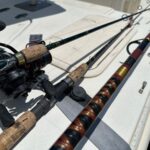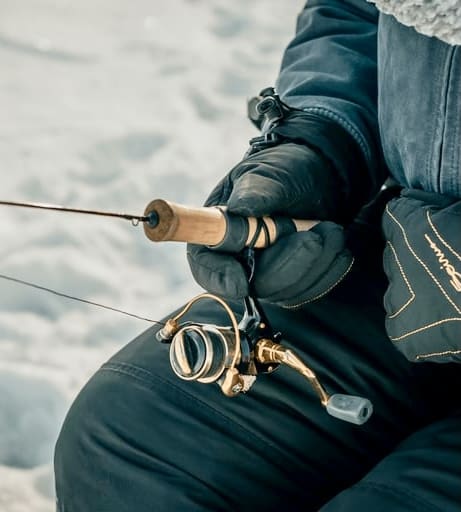
Do you really need a special ‘ice fishing reel’ or will a regular fishing reel work? What’s the difference anyway?
Table of Contents
Ice Fishing Reel vs Regular Reel
Ice Fishing Reels are typically constructed with less ball bearings than a traditional spinning reel. This is because they are not used for casting and retrieving. Additionally, high quality ice fishing reels are made with components and lubricants that will not freeze, even in frigid temperatures. Otherwise, there is no main difference and many anglers use regular reels for ice fishing.
Can you use a regular fishing reel for ice fishing?
Yes, you can use a regular fishing reel for ice fishing. Many anglers swap out their ‘summer’ time or year-round fishing reels and put them on ice fishing rods during the hard ice season.
However, there are a few things you should consider before making the swamp:
Quality ice fishing reels typically use lubricants that are specifically meant to withstand freezing temperatures. Most traditional spinning reels do not have ‘winterized’ lubricants and you may notice a performance difference in temperatures below 15 degrees Fahrenheit.
Also, Ice fishing reels are very small- usually in the 500-2500 size range. Many traditional spinning reels used during the warmer months are in the 2500-4000 size range, so that larger size may be a bit cumbersome when fishing in an ice hut or tent.
Lastly, be sure to check what type of fishing line you are using. During the warmer months, monofilament, braided line, and fluorocarbon all work fine…
But, using that regular fishing reel and line may give you problems in the ice. Avoid using braided lines as it can easily freeze.
You may want to consider having a spare spool of ice fishing line. Ice fishing line made from monofilament and fluorocarbon are usually thinner and more sensitive; perfect for detecting subtle bites from sluggish fish.
Can you use any spinning reel for ice fishing?
Although any spinning reel will work for ice fishing, you are likely to have more success and control using a lighter and smaller spinning reel.
Spinning reels in the 500-2500 size range are ideal for ice fishing because they are geared and designed for ultralight applications.
For example, the drag on a 4000 or 5000 sized spinning reel is far too strong, and the line retrieve ratio is far too big for micro jigs 20 feet down.
Always try and match your equipment. Ice fishing rods are small, so your reel and line should. be too.
What size reel is best for ice fishing?
The most popular reel size for ice fishing is a 1000 size reel spooled with either 4lb or 6lb test. This is a great all-around size capable of catching small panfish like bluegill, or large-sized lake trout.
See Also: What Kind Of Fish Do You Catch Ice Fishing?
Are inline ice fishing reels worth it?
Inline reels are a fairly new innovation in the world of ice fishing reels, and it seems you either love them or hate them.
One major drawback of using a traditional spinning reel while ice fishing is the ‘line twist‘ that can happen as the monofilament line is twisted around a spool.
This can be really frustrating when you see your jig spinning in circles below the surface.
Inline spinning reels prevent line twist. Just as their name implies, the fishing line is ‘in-line‘ with the spool and rod. Very similar to a traditional fly-fishing reel.
This means you dont get line twist, and have the most direct control over your line and lure or bait. This REALLY pays off when your fishing with micro jigs!
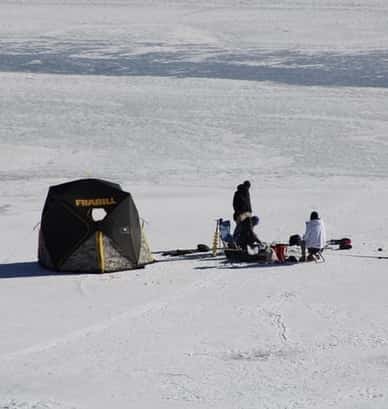
On in-line ice fishing reels, the gearing and ratio are usually much less than spinning reels, (1:1 or 1:2 ratio), which makes fishing in a shallow water great.
But if your ice fishing deep, that’s a lot of cranking.
Many inline reels have ‘clickers’ which is a great feature if your fishing with bait. Turn the clicker on/off at anytime to indicate when line is being taken out.
Some hardcore traditionalists will say they in-line ice fishing reels are no good, but I personally think they have a use in ice fishing.
They take some getting used to, but once you do, you’ll see why they are preferred by pros and guides!
See Also: What Are The Different Types Of Fishing Reels?
How do I keep my reels from freezing?
If your reels are freezing on you while fishing, well, your fishing in some super cold weather!
More than likely, the line of your reel (and moisture it accumulates) is freezing on the spool causing it to feel like the reel is freezing.
To prevent this, avoid using braided or dacron lines as it will absorb water and freeze easily.
You can also fish near a portable heater, or in an ice tent to raise temperatures.
Lastly, try using a silicone rag, or silicone spray on your fishing reel before fishing. This will act as a lubricant and prevent water molecules from freezing on metal surfaces.
How do you set the drag on a ice reel?
The drag on an ice fishing reel should be set based on the line, rod action, and size of fish you are targeting.
As a general rule of thumb, your drag should be set to 25% of your fishing line lb test.
For example, if you are fishing with 4 lb test line, your drag should be set for around 1lb.
To do this find something that weighs 1 pound (A jar of peanut butter or can of beans weighs about a pound) and tie it onto the end of your line.
Now attempt to lift it off the ground with your rod. If the drag is too loose, it won’t lift and you need to tighten it a few clicks.
If the drag is too tight, it will come off the ground completely without utilizing the drag system at all.
Adjust the drag by turning the knob, until it’s just tight enough for you to lift up the 1 lb object off the ground, while still making a ‘tink’ sound.
As you fish more with your rod and reel, you will learn to adjust the drag on the go while fighting a fish, or change it based on your bait and fishing setup.
Good luck!
See Also: Ice Fishing At Night For Black Crappie
If you haven’t guessed yet, I love fishing and everything about it!
To learn more about why I started Panfish Nation, visit the About page and follow along on Social Media:


Download a copy of my FREE Lure Color Selection Chart & Knot Guide!
Stay up to date with fishing reports, tackle reviews, industry news, and much more! We respect your privacy, unsubscribe at any time.
- Crazy Facts About the World Record Crappie

- What Size Hooks for Smallmouth Bass? Quick Guide

- Large and in Charge-Mouth: 10 of the Best Bass Lures of All Time (And Where to Buy Them)

- Emperor of the Sun(fish): What You Need to Know About the World Record Bluegill
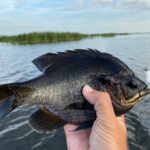
- The Seven Best Lures for Fall Bass Fishing
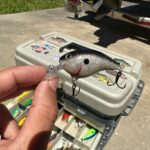
- Which Fishing Line is Best for Bass Fishing With A Spinning Reel?
